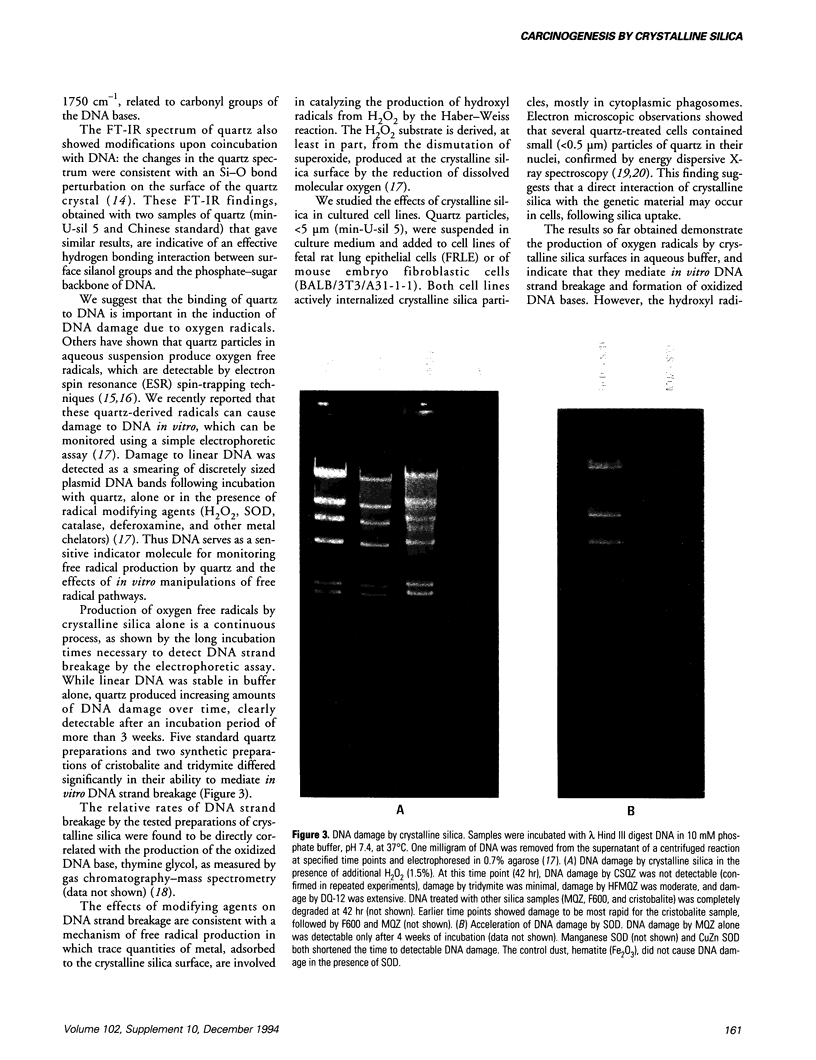Abstract
The carcinogenic effects of crystalline silica in rat lungs were extensively demonstrated by many experimental long-term studies, showing a marked predominance for adenocarcinomas originating from alveolar type II cells and associated with areas of pulmonary fibrosis (silicosis). In contrast with its effects in rats, silica did not induce alveolar type II hyperplasia and lung tumors in mice and hamsters, pointing to a critical role for host factors. Using these animal models, we are investigating the role of cytokines and other cellular mediators on the proliferation of alveolar type II cells. Immunohistochemical localization of TGF-beta 1 precursor in alveolar type II cells adjacent to silicotic granulomas was shown to occur in rats, but not in mice, and hamsters, suggesting a pathogenetic role for this regulatory growth factor. Recent investigations in our laboratory on the biologic mechanisms of crystalline silica included determination of anionic sites on crystalline silica surfaces by binding of the cationic dye Janus Green B; binding of crystalline silica to DNA, demonstrated by infrared spectrometry; production of oxygen radicals by crystalline silica in aqueous media; induction of DNA strand breakage and base oxidation in vitro and its potentiation by superoxide dismutase and by hydrogen peroxide; and induction by crystalline silica of neoplastic transformation and chromosomal damage in cells in culture. On the basis of these in vitro studies, we propose that DNA binding to crystalline silica surfaces may be important in silica carcinogenesis by anchoring DNA close to sites of oxygen radical production on the silica surface, so that the oxygen radicals are produced within a few A from their target DNA nucleotides.
Full text
PDF




Images in this article
Selected References
These references are in PubMed. This may not be the complete list of references from this article.
- Daniel L. N., Mao Y., Saffiotti U. Oxidative DNA damage by crystalline silica. Free Radic Biol Med. 1993 May;14(5):463–472. doi: 10.1016/0891-5849(93)90103-2. [DOI] [PubMed] [Google Scholar]
- Daniel L. N., Mao Y., Vallyathan V., Saffiotti U. Binding of the cationic dye, Janus green B, as a measure of the specific surface area of crystalline silica in aqueous suspension. Toxicol Appl Pharmacol. 1993 Nov;123(1):62–67. doi: 10.1006/taap.1993.1221. [DOI] [PubMed] [Google Scholar]
- Hei T. K., Piao C. Q., He Z. Y., Vannais D., Waldren C. A. Chrysotile fiber is a strong mutagen in mammalian cells. Cancer Res. 1992 Nov 15;52(22):6305–6309. [PubMed] [Google Scholar]
- Hesterberg T. W., Barrett J. C. Dependence of asbestos- and mineral dust-induced transformation of mammalian cells in culture on fiber dimension. Cancer Res. 1984 May;44(5):2170–2180. [PubMed] [Google Scholar]
- Leheup B. P., Federspiel S. J., Guerry-Force M. L., Wetherall N. T., Commers P. A., DiMari S. J., Haralson M. A. Extracellular matrix biosynthesis by cultured fetal rat lung epithelial cells. I. Characterization of the clone and the major genetic types of collagen produced. Lab Invest. 1989 Jun;60(6):791–807. [PubMed] [Google Scholar]
- Muhle H., Takenaka S., Mohr U., Dasenbrock C., Mermelstein R. Lung tumor induction upon long-term low-level inhalation of crystalline silica. Am J Ind Med. 1989;15(3):343–346. doi: 10.1002/ajim.4700150309. [DOI] [PubMed] [Google Scholar]
- Nolan R. P., Langer A. M., Harington J. S., Oster G., Selikoff I. J. Quartz hemolysis as related to its surface functionalities. Environ Res. 1981 Dec;26(2):503–520. doi: 10.1016/0013-9351(81)90226-7. [DOI] [PubMed] [Google Scholar]
- Shi X. L., Dalal N. S., Vallyathan V. ESR evidence for the hydroxyl radical formation in aqueous suspension of quartz particles and its possible significance to lipid peroxidation in silicosis. J Toxicol Environ Health. 1988;25(2):237–245. doi: 10.1080/15287398809531205. [DOI] [PubMed] [Google Scholar]
- Spiethoff A., Wesch H., Wegener K., Klimisch H. J. The effects of Thorotrast and quartz on the induction of lung tumors in rats. Health Phys. 1992 Jul;63(1):101–110. doi: 10.1097/00004032-199207000-00011. [DOI] [PubMed] [Google Scholar]
- Vallyathan V., Shi X. L., Dalal N. S., Irr W., Castranova V. Generation of free radicals from freshly fractured silica dust. Potential role in acute silica-induced lung injury. Am Rev Respir Dis. 1988 Nov;138(5):1213–1219. doi: 10.1164/ajrccm/138.5.1213. [DOI] [PubMed] [Google Scholar]
- Williams A. O., Flanders K. C., Saffiotti U. Immunohistochemical localization of transforming growth factor-beta 1 in rats with experimental silicosis, alveolar type II hyperplasia, and lung cancer. Am J Pathol. 1993 Jun;142(6):1831–1840. [PMC free article] [PubMed] [Google Scholar]




